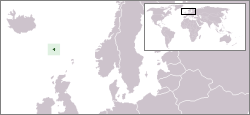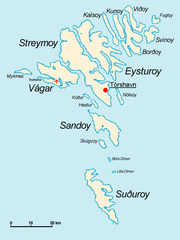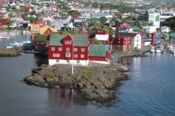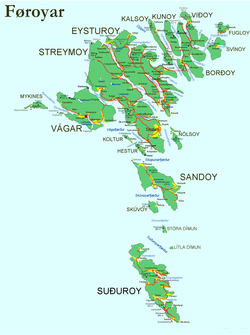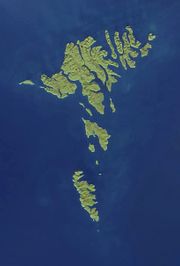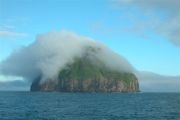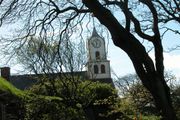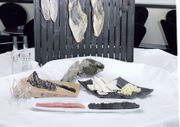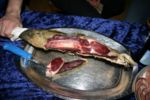Faroe Islands
2007 Schools Wikipedia Selection. Related subjects: Geography of Great Britain
| Føroyar Færøerne Faroe Islands |
|||||
|
|||||
| Anthem: Tú alfagra land mítt "You, my most beauteous land" |
|||||
| Capital (and largest city) |
Tórshavn |
||||
| Official languages | Faroese | ||||
|---|---|---|---|---|---|
| Government | |||||
| - Monarch | Margrethe II | ||||
| - Prime Minister | Jóannes Eidesgaard | ||||
| Independence | None (part of the Kingdom of Denmark) |
||||
| - Home rule | 1948 | ||||
| Area | |||||
| - Total | 1,399 km² ( 180th) 540 sq mi |
||||
| - Water (%) | 0.5 | ||||
| Population | |||||
| - August 2006 estimate | 47,017 ( 208th) | ||||
| - 2004 census | 48,470 | ||||
| - Density | 34/km² ( 169th) 88/sq mi |
||||
| GDP ( PPP) | 2005 estimate | ||||
| - Total | $1.0 billion ( not ranked) | ||||
| - Per capita | $22,000 (2001 estimate) ( not ranked) | ||||
| HDI (2003) | 0.9411 (high) ( 14th) | ||||
| Currency | Faroese króna2 ( DKK) |
||||
| Time zone | GMT ( UTC) | ||||
| - Summer ( DST) | EST ( UTC+1) | ||||
| Internet TLD | .fo | ||||
| Calling code | +298 | ||||
| 1 Information for Denmark including the Faroe Islands and Greenland. 2 The currency is issued at par to the Danish kroner printed with Faroese motifs, but following same standard (size and security features of the Danish coins and banknotes). Faroese krónur (singular króna) use the Danish ISO 4217 code DKK. |
|||||
The Faroe Islands or simply Faroes ( Faroese: Føroyar, meaning "Sheep Islands", Danish: Færøerne) are a group of islands in Northern Europe, between the Norwegian Sea and the North Atlantic Ocean, about one-half of the way from Iceland to Norway. They have been an autonomous region of the Kingdom of Denmark since 1948 and have, over the years, taken control of most matters, except defence (they have a small organized native military in Mjørkadalur, including a small Police force and Coast Guard) and foreign affairs which is the responsibility of Denmark.
The Faroes have close traditional ties to Iceland, Shetland, Orkney, the Outer Hebrides and Greenland. The archipelago was detached from Norway in 1814. The Faroes are represented in the Nordic Council as a part of the Danish Delegation.
History
The early history of the Faroe Islands is not very clear. The earliest text which is believed to include a description of the Faroe Islands, was written by an Irish monk named Dicuil. Dicuil had met a "man worthy of trust" who related to his master, the abbot Sweeney (Suibhne), how he had landed on the Faroe Islands after having navigated "two days and a summer night in a little vessel of two banks of oars." Around A.D. 825, Dicuil wrote a book, Liber de Mensura Orbis Terrae, (Measure/description of the sphere of the earth) in which he states:
- "Many other islands lie in the northerly British Ocean. One reaches them from the northerly British islands, by sailing directly for two days and two nights with a full sail in a favourable wind the whole time.... Most of these islands are small, they are separated by narrow channels, and for nearly a hundred years hermits lived there, coming from our Scotland (i.e. Ireland) by boat. But just as these islands have been uninhabited from the beginning of the world, so now the Norwegian pirates have driven away the monks; but countless sheep and many different species of sea-fowl are to be found there..."
The physical description of these islands and the travel time described, fits the Faroe Islands, and the name Faeroe is thought to mean Sheep Islands. According to this, the first settlers in the Faroe Islands were Irish monks, who introduced sheep and oats to Faroe. Proving this theory, recent pollen analysis show that oats were grown in the Faroes about the year 650 A.D.
Later the Vikings replaced the Irish settlers, bringing the Old Norse language to the islands, which locally evolved into the modern Faroese language spoken today. Although the settlers were Norwegians, most of them probably didn't come from Norway, but rather from the Norwegian settlements in Shetland, Orkney and around the Irish Sea, so-called Norse-Gaels.
The first Norwegian settler in the Faroe Isles mentioned in the " Landnama Bók" was called Grímr Camban. While his fist name "Grímr" is obvious Norwegian, his surname "Cambán" is Gaelic. Thus he most likely was a so-called Norse-Gael from the British Isles. These Norse-Gaels had intermarried with the local Gaelic speaking people in Britain, a feature that is still visible in the Faroese genes today, which prove to be mixed Scandinavian-British.
The fact that settlers from Norway also settled in the Faroe Islands is proven by a rune stone found in the village of Sandavágur on Vágoy Island. It says: "Þorkil Ønundsson, austmaðr af Hrua landi, byggði þennan stað fystr". I.e. "Thorkil Oenundsson, eastman (Norwegian) from Rogaland, settled first in this place (Sandavágur)".
This description "eastman" (from Norway) has to be seen together with the discription "westman" (From Ireland/Scotland) which is to be found in local place-names such as " Vestmanna-havn" i.e. "Irish-mens harbour" in the Faroe Isles, and " Vestmannaeyjar" i.e. "Irish-mens islands" in Iceland.
According to Færeyinga Saga emigrants who left Norway to escape the tyranny of Harald I of Norway settled in the islands about the beginning of the 9th century. Early in the 11th century, Sigmund, whose family had flourished in the southern islands but had been almost exterminated by invaders from the northern islands, escaped to Norway and was sent back to take possession of the islands for Olaf Tryggvason, king of Norway. He introduced Christianity and, though he was subsequently murdered, Norwegian supremacy was upheld. Norwegian control of the islands continued until 1380, when Norway entered into a union with Denmark, which gradually evolved into Danish control of the islands. The reformation reached the Faroes in 1538. When the union between Denmark and Norway was dissolved as a result of the Treaty of Kiel in 1814, Denmark retained possession of the Faroe Islands.
The monopoly trade over the Faroe Islands was abolished in 1856. Since then, the country developed towards a modern fishery nation with its own fleet. The national awakening since 1888 was first based on a struggle for the Faroese language, and thus more culturally oriented, but after 1906 was more and more politically oriented after the foundation of the political parties of the Faroe Islands.
On April 12, 1940, the Faroes were invaded and occupied by British troops. The move followed the invasion of Denmark by Nazi Germany and had the objective of strengthening British control of the North Atlantic (see Second Battle of the Atlantic). In 1942– 43 the British Royal Engineers built the only airport in the Faroes, the Vágar Airport. Control of the islands reverted to Denmark following the war, but in 1948 a home rule regime was implemented granting a high degree of local autonomy. The Faroes declined to join Denmark in entering the European Community (now European Union) in 1973. The islands experienced considerable economic difficulties following the collapse of the fishing industry in the early 1990s, but have since made efforts to diversify the economy. Support for independence has grown and is the objective of the government.
Politics
The islands are administratively divided into 34 municipalities with about 120 cities and villages.
Traditionally, there are also the 6 sýslur ( Norðoyar, Eysturoy, Streymoy, Vágar, Sandoy and Suðuroy). Sýsla means district and although it is only a police district today, it is still commonly understood as a geographical region. In earlier times, each sýsla had its own ting, the so called várting (spring ting).
Today, elections are held in the municipalities, on a national level for the Løgting, and inside the Kingdom of Denmark for the Folketing. For the Løgting elections there are 7 electoral districts, each one comprising a sýsla, while Streymoy is divided into a northern and southern part (Tórshavn region).
The Government of the Faroes holds the executive power in local government affairs. The Head of the government is called the Løgmaður or Prime Minister in English. Any other member of the cabinet is called a landsstýrismaður.
The Faroes and Denmark
The Treaty of Kiel in 1814 terminated the Danish-Norwegian union. Norway came under the rule of the King of Sweden, but the Faroe Islands, Iceland and Greenland remained as possessions of Denmark. In continuation of this the Løgting was abolished ( 1816), and the Faroe Islands were to be governed as a regular Danish amt, with the Amtmand as its head of government. In 1851 the Løgting was resurrected, but served mainly as an advisory power until 1948.
At the end of the Second World War a portion of the population favoured independence from Denmark, and on September 14, 1946 a public election was held on the question of secession. It is not considered a referendum, as the parliament was not bound to follow the decision of the vote. This was the first time that the Faroese people were asked if they favoured independence or if they wanted to continue as a part of the Danish Kingdom. The outcome of the vote produced a small majority in favour of secession, but the coalition in parliament could not reach a resolution on how this election should be interpreted and implemented, and because of these irresolvable differences the coalition fell apart. A parliament election was held just a few months later, in which the political parties who favoured staying in the Danish Kingdom went up in votes and formed a coalition. Based on their growth in votes they chose not to pass the secession. Instead a compromise was made and the Folketing passed a home-rule law which came into effect in 1948. The Faroe Islands' status as a Danish amt was brought to an end with the home-rule law; the Faroe Islands were given a high degree of self-governance, supported by a substantial annual subsidy from Denmark.
The islanders are about evenly split between those favouring independence and those who prefer to continue as a part of the Kingdom of Denmark. Within both camps there is, however, a wide range of opinions. Of those who favour independence some are in favour of an immediate unilateral declaration. Others see it as something to be attained gradually and in full consent with the Danish government and the Danish nation. In the unionist camp there are also many who foresee and welcome a gradual increase in autonomy even as strong ties to Denmark are maintained.
The Faroes and the EU
The Faroe Islands are not part of the EU, as explicitly asserted by both Rome treaties. Moreover, a protocol to the treaty of accession of Denmark to the European Communities stipulates that Danish nationals residing in the Faroe Islands are not to be considered as Danish nationals within the meaning of the treaties. Hence, Danish people living in the Faroes are not citizens of the European Union (however, other EU nationals living there remain EU citizens). The Faroes are not covered by the Schengen free movement agreement but there are no border checks when travelling between the Faroes and any Schengen country.
Geography
The Faroe Islands are an island group consisting of 18 islands, off the coast of Northern Europe, between the Norwegian Sea and the north Atlantic Ocean, about one-half of the way from Iceland to Norway. Its coordinates are , and it has 1,399 square kilometres (540 sq. mi) in area, and includes no major lakes or rivers. There are 1,117 kilometres (694 mi) of coastline, and no land boundaries with any other country. The only island that is uninhabited is Lítla Dímun.
The Faroe Islands generally have cool summers and mild winters, with a usually overcast sky and frequent fog and heavy winds. The fog often causes delays of aeroplanes. The islands are rugged and rocky with some low peaks; the coasts are mostly bordered by cliffs. The highest point is Slættaratindur, 882 metres (2,894 ft) above sea level.
See also:
- List of regions in the Faroe Islands
- Maps of the Faroe Islands
Natural history and biology
A collection of the marine algae from the Faroes resulting from a survey sponsored by NATO, the British Museum (Natural History) and Carlsberg Foundation is preserved in the Ulster Museum catalogue numbers: F3195 - F3307. It is one of 10 exsiccatae sets.
Economy
After the severe economic troubles of the early 1990s, brought on by a drop in the vital fish catch and poor management of the economy, the Faroe Islands have come back in the last few years, with unemployment down to 5% in mid- 1998. In 2006 unemployment declined to 3%, one of the lowest rates in Europe. Nevertheless, the almost total dependence on fishing means the economy remains extremely vulnerable. The Faroese hope to broaden their economical base by building new fish-processing plants. Petroleum found close to the Faroese area gives hope for deposits in the immediate area, which may lay the basis to sustained economic prosperity.
Since 2000, new information technology and business projects have been fostered in the Faroe Islands to attract new investment. The result from these projects is not yet known but is hoped to bring a better market economy to the Faroe Islands.
The Faroes have one of the lowest unemployment rates in Europe, but this is not necessarily a sign of a recovering economy, as many young students move to Denmark and other countries once they are finished with high school. This leaves a largely middle-aged and elderly population that may lack the skills and knowledge to take IT positions on the Faroes.
Transportation
Vágar Airport has scheduled service to destinations from Vágoy Island. The largest Faroese airline is Atlantic Airways; there is also the new rival FaroeJet.
Due to the rocky terrain and relatively small size of the Faroe Islands, its transportation system was not as extensive as other places of the world. This situation has changed, and today the infrastructure has been developed extensively. Some 80% of the population in the islands is connected by under-ocean tunnels, bridges and embankments which binds the 3 largest islands and 3 comparatively large islands to the northeast together, while the other two large islands to the south of the main area are connected to the main area with brand new modern, fast ferries. There are good roads that lead to every village in the islands except 7 of the smaller islands with only one village each.
Demographics
The vast majority of the population are ethnic Faroese, of Norse and Celtic descent.
Recent DNA analyses have revealed that the male genes are 87% Scandinavian and the female genes are 84% British.
Of the approximately 48,000 inhabitants of the Faroe Islands (16,921 private households (2004)) 98% are realm citizens, meaning Faroese, Danish or Greenlandic. By birthplace one can derive the following origins of the inhabitants: born on the Faroes 91.7%, in Denmark 5.8% and in Greenland 0.3%. The largest group of foreigners are Icelanders comprising 0.4% of the population, followed by Norwegians and Polish which each comprising 0.2%. Altogether, on the Faroe Islands there are people from 77 different nationalities.
Faroese is spoken in the entire country. It is not possible to say exactly how many people speak the Faroese language. This is because of two reasons: Firstly, many ethnic Faroese live in Denmark and few who are born there return to the Faroes with their parents or as adults. Secondly, there are some established Danish families on the Faroes who speak Danish at home.
The Faroese language is the smallest of the Germanic languages. In the 20th Century Faroese became the host language; Danish only has the purpose of a language of commerce.
Also, the Faroese language policy provides for an active creation of new terms in Faroese suitable for modern life.
Population trends
If the first inhabitants of the Faroe Islands were Irish monks, then they must have lived as a very small group of settlers. Later, when the Vikings colonised the Islands, there was a considerable increase in the population. However, it never exceeded 5000 until the 18th Century. Around 1349 about half of the islands' people died of the plague.
Only through the rise of the deep sea fishery (and thus independence from the difficult agriculture) and with general progress in the health service was a rapid population growth possible in the Faroes; beginning in the 18th Century, the population increased tenfold in 200 years.
At the beginning of the 1990s the Faroe Islands entered a heavy economic crisis with heavy, noticeable emigration; however this trend reversed in subsequent years to a net immigration.
| Year | Inhabitants |
|---|---|
| 1327 | ca. 4,000 |
| 1350 | ca. 2,000 |
| 1769 | 4,773 |
| 1801 | 5,255 |
| 1834 | 6,928 |
| 1840 | 7,314 |
| 1845 | 7,782 |
| 1850 | 8,137 |
| 1855 | 8,651 |
| 1880 | 11,220 |
| 1900 | 15,230 |
| 1911 | ca. 18,800 |
| 1925 | 22,835 |
| 1950 | 31,781 |
| 1970 | ca. 38,000 |
| 1975 | 40,441 |
| 1985 | 45,749 |
| 31 December 1989 | 47,787 |
| 31 December 1995 | 43,358 |
| 31 December 1996 | 43,784 |
| 31 December 1997 | 44,262 |
| 31 December 1998 | 44,817 |
| 31 December 1999 | 45,409 |
| 31 December 2000 | 46,196 |
| 31 December 2001 | 46,996 |
| 31 December 2002 | 47,704 |
| 31 December 2003 | 48,214 |
| 1 December 2004 | 48,353 |
Urbanization
The Faroese population is spread across most of the country; and it was not until recent decades that significant urbanization occurred. Industrialization has been remarkably decentralized and the country has therefore maintained quite a viable rural culture. Nevertheless, villages with poor harbour facilities have been the losers of the development from agriculture to fishing, and in the most peripheral agricultural areas there are scarcely any young people left. This includes areas such as Fugloy, Svínoy, Mykines, Skúvoy and Dímun, which have extremely poor connections to the rest of the country, and cannot always be reached every day, often due to bad weather. In recent decades, the village-based social structure has nevertheless been placed under pressure; instead there has been a rise in "centres" that are able to provide goods in demand in the periphery. This has meant that shops and services are now relocating en masse from the villages into the centres.
Religion
According to Færeyinga Saga, Sigmundur Brestisson brought Christianity to the islands in 999. However, a find at a dig site in Leirvík suggests that the Faroes were Christian maybe 150 years before that. The reformation was completed in the Faroe Islands on 1 January 1540. According to official statistics from 2002, 84.1% of the Faroese population are members of the state church, the Faroese People's Church (Fólkakirkjan), a form of Lutheranism. Faroese members of the clergy who have had historical importance include V. U. Hammershaimb (1819-1909), Frederik Petersen (1853-1917) and perhaps most significantly Jákup Dahl (1878-1944) who had a great influence in making sure that the Faroese language was spoken in the church instead of Danish.
In the late 1820s the Christian Evangelical religious movement the Plymouth Brethren was established in England. Around 1860 a member of this movement William Gibson Sloan travelled to the Faroes from Shetland. At the turn of the 19th Century the Faroese Plymouth Brethren counted 30 members. Today, approximately 10% of the Faroese population are members of the Brethren Community (in Faroese, Brøðrasamkoman), as they now call themselves. About 5% belong to other Christian churches, e.g. the Adventists who operate a private school in Tórshavn. The Catholic clergy comprises approximately 170 members. The municipality of Tórshavn operates their old Franciscan school. There are also around fifteen Bahá'í who meet at four different places. Unlike Iceland, there is no organized Ásatrú community.
The best known church buildings in the Faroe Islands include St. Olafs Church and the unfinished Magnus Cathedral in Kirkjubøur; the Vesturkirkjan and the Maria Church, both of which are situated in Tórshavn; the church of Fámjin; the octagonal church in Haldarsvík; Christianskirkjan in Klaksvík and also the two pictured here.
In 1948 Victor Danielsen (Plymouth Brethren) completed the first bible translation. It was translated into Faroese from different modern languages. Jacob Dahl and Osvald Viderø (Fólkakirkjan) completed the second translation in 1961. The latter was translated from the original languages into Faroese.
Culture
Technically, the phrase "Faroe Islands" is a pleonasm, since the suffixes øerne and oyar mean "islands" in Danish and Faroese, respectively. The Faroes have a culture very much their own, but it holds elements in common with Norway, Iceland, and Denmark.
The Faroese language, spoken by Faroese people, is most similar to Icelandic and Old Norse.
Ólavsøka
The national holiday, Ólavsøka, is on the 29th July, commemorating the death of Saint Olaf. Festivities commence on the evening of the 28th. On the 29th, the Faroese Parliament meets for a service in Tórshavn Cathedral prior to a special Parliamentary session. Celebrations are marked by rowing competitions (notably in Tórshavn harbour), art exhibitions and the famous Faroese dance.
The Nordic House in the Faroe Islands
The Nordic House in the Faroe Islands (in Faroese Norðurlandahúsið) is the most important cultural institution in the Faroes. Its aim is to support and promote Nordic and Faroese culture, locally and in the Nordic region. Erlendur Patursson (1913-1986), Faroese member of the Nordic Council, brought forward the idea of a Nordic cultural house in the Faroe Islands. A Nordic competition for architects was held in 1977, where 158 architects participated. Winners were Ola Steen from Norway and Kolbrún Ragnarsdóttir from Iceland. By staying true to folklore the architects built the Nordic House to resemble an enchanting hill of elves. The building is considered to be one of the most beautiful in Scandinavia. The house opened in Tórshavn in 1983. The Nordic House is organized as a cultural organization under the Nordic Council of Ministers. The Nordic House is run by a steering committee of 8, of which 3 are Faroese and 5 from the outside Nordic countries. There is also a local advisory body of 15 members, representing Faroese cultural organizations. The House is managed by a director appointed by the steering committee for a four-year term.
Traditional food
Traditional Faroese food is mainly based on meat and potatoes and uses few fresh vegetables. Mutton is the basis of many meals, and one of the most popular treats is skerpikjøt, well aged, wind-dried mutton which is quite chewy. The drying shed, known as a hjallur, is a standard feature in many Faroese homes, particularly in the small towns and villages. Other traditional foods are ræst kjøt (semi-dried mutton) and ræstur fiskur, matured fish. Another Faroese specialty is grind og spik, pilot whale meat and blubber. Well into the last century meat and blubber from the pilot whale meant food for a long time. Fresh fish also features strongly in the traditional local diet, as do seabirds, such as puffins, and their eggs.
The Faroe Islands in popular culture
- In the book Nineteen Eighty-Four by George Orwell, a floating fortress has been anchored between the Faroe Islands and Iceland on ca. 4 April 1984.
- The climax of John Buchan's novel The Isle of Sheep takes place on the Faroes.
- William R. Trotter's novel Warrener's Beastie is principally set in the Faroes.
- Susanna Kaysen's novel "Far Afield" involves the Faroes and takes place in part there.
- Laureate Dutch writer Bernlef situated his novel "Onder IJsbergen" in the Faroes.


